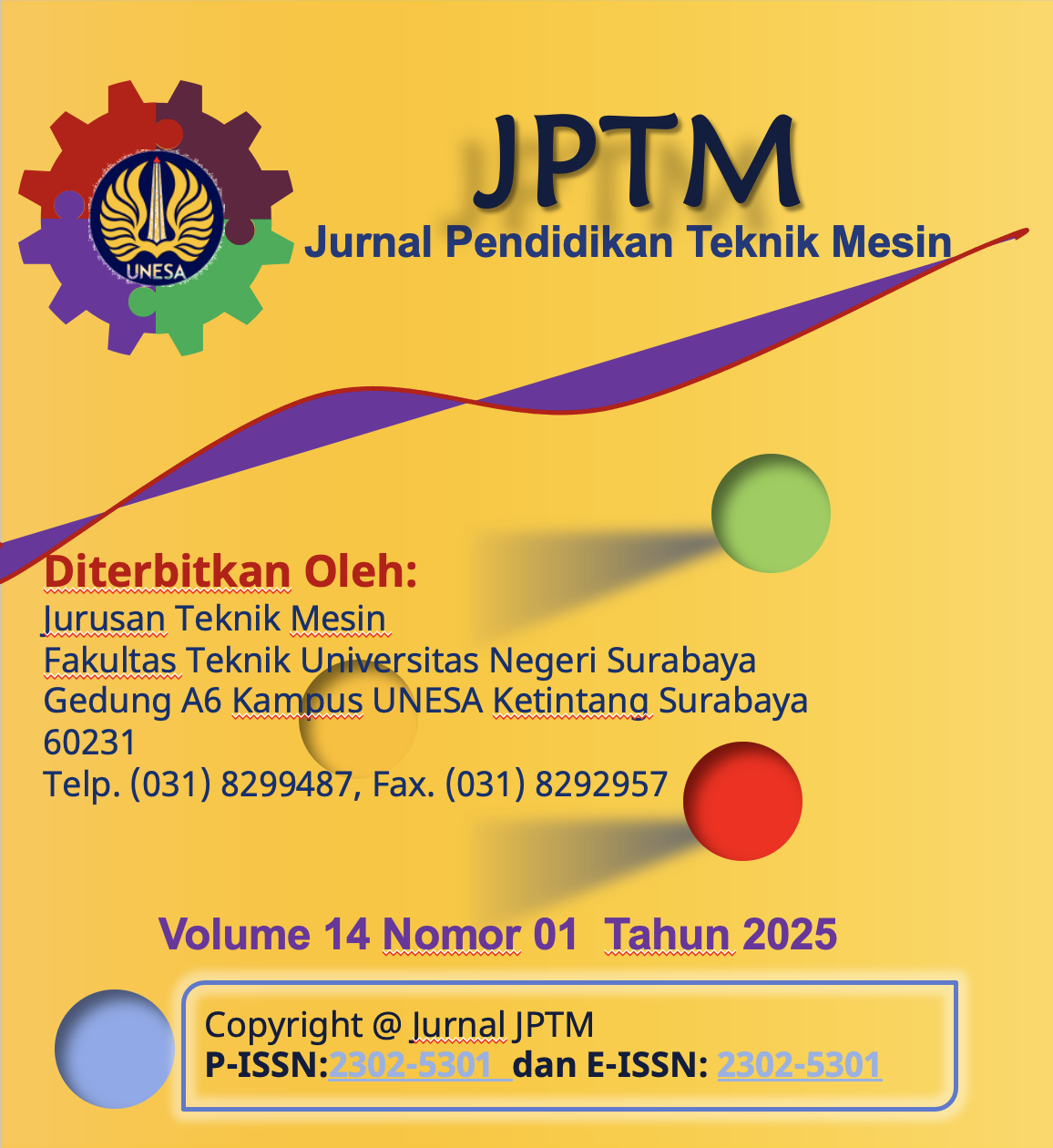PENGEMBANGAN MODUL AUTODESK INVENTOR 2023 SEBAGAI MEDIA PEMBELAJARAN DESAIN TEKNIK BERBASIS CAD UNTUK MAHASISWA TEKNIK MESIN UNESA
Keywords:
Learning module, Autodesk Inventor 2023, technical design, CAD, ADDIE developmentAbstract
This study aims to develop and evaluate the feasibility and effectiveness of the Autodesk Inventor 2023 module as a learning medium for CAD-based technical design, targeted at Mechanical Engineering students. The research employed the ADDIE development model, which includes the stages of analysis, design, development, implementation, and evaluation. The research instruments included module validation sheets, pre-post test questions, and a student perception questionnaire. The validation results from nine experts—consisting of subject matter, media, and language specialists—indicated that the module was in the highly feasible category with an average score of 3.69. The pre-post test instrument and student perception questionnaire were also deemed highly feasible, with respective scores of 3.79 and 4.00. A small-scale trial was conducted on ten students through pre-test and post-test, showing a significant increase in learning outcomes with an average N-Gain score of 0.78, categorized as high. Furthermore, students’ perceptions of the module showed an average score of 3.59, which falls under the very satisfied category. In conclusion, the Autodesk Inventor 2023 module is feasible, effective, and well-received as a learning tool for CAD-based technical design instruction.
Downloads
References
Achmad, M., & Ngadiyono, N. (2016). Pengembangan modul pembelajaran berbasis Contextual Teaching and Learning pada materi Autodesk Inventor. Jurnal Pendidikan Teknik Mesin, 18(2), 67–75.
Achmad, M., & Ngadiyono, N. (2016). Pengembangan modul pembelajaran berbasis Contextual Teaching and Learning pada materi Autodesk Inventor. Jurnal Pendidikan Teknik Mesin, 18(2), 67–75.
Akbar, F., Permana, I., & Ramdhani, A. (2024). Pengembangan modul CAD Inventor berbasis model 4D pada mata kuliah desain kendaraan. Jurnal Pendidikan Teknik Mesin, 22(1), 55–65.
Daryanto. (2013). Media pembelajaran. Yogyakarta: Gava Media.
Depdiknas. (2008). Panduan Pengembangan Bahan Ajar. Jakarta: Direktorat Jenderal Manajemen Pendidikan Dasar dan Menengah.
Dick, W., & Carey, L. (2001). The systematic design of instruction (5th ed.). New York: Longman.
Dieter, G. E., & Schmidt, L. C. (2013). Engineering design (5th ed.). New York: McGraw-Hill.
Hake, R. R. (1998). Interactive-engagement versus traditional methods: A six-thousand-student survey of mechanics test data for introductory physics courses. American Journal of Physics, 66(1), 64–74.
Heinich, R., Molenda, M., Russell, J. D., & Smaldino, S. E. (2002). Instructional media and technologies for learning (7th ed.). Upper Saddle River, NJ: Merrill Prentice Hall.
Noer Arifin, & Susanti, A. (2018). Pengembangan modul pembelajaran Autodesk Inventor menggunakan model Dick & Carey. Jurnal Pendidikan Teknik Mesin, 16(1), 22–30.
Nurcahyo, H., & Khasanah, U. (2016). Pengembangan media pembelajaran interaktif berbasis multimedia. Jurnal Pendidikan Teknologi dan Kejuruan, 18(1), 88–96.
Prastowo, A. (2014). Panduan kreatif membuat bahan ajar inovatif. Yogyakarta: DIVA Press.
Ramos, Basilio, & Melgosa, Carlos. (2020). “CAD Learning in Mechanical Engineering at Universities.” Computer-Aided Design and Applications, 18(1), 24–41.
Sugiyono. (2019). Metode penelitian pendidikan: Pendekatan kuantitatif, kualitatif, dan R&D. Bandung: Alfabeta.
Trianto. (2010). Model pembelajaran terpadu: Konsep, strategi, dan implementasinya dalam kurikulum tingkat satuan pendidikan (KTSP). Jakarta: Bumi Aksara.
Trianto. (2010). Model pembelajaran terpadu: Konsep, strategi, dan implementasinya dalam kurikulum tingkat satuan pendidikan (KTSP). Jakarta: Bumi Aksara.
Weijters, B., Geuens, M., & Schillewaert, N. (2010). The stability of individual response styles. Psychological Methods, 15(1), 96–110.
Zeid, I. (2005). Mastering CAD/CAM (2nd ed.). New York: McGraw-Hill.
Downloads
Published
Issue
Section
 Abstract views: 192
,
Abstract views: 192
, PDF Downloads: 96
PDF Downloads: 96





